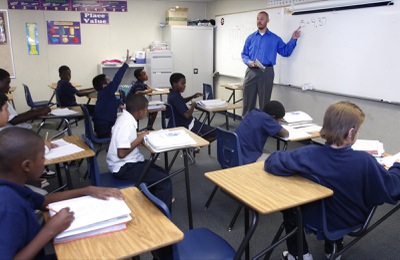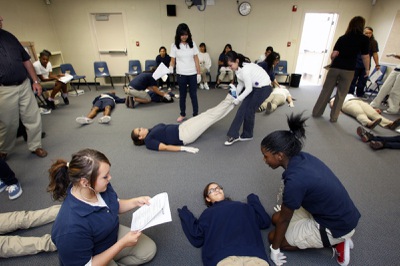Thursday, Oct. 29, 2009 | 2 a.m.
Sun Archives
- Single-sex classes being praised on many levels (7-19-2009)
Sun Coverage
For six years a Las Vegas junior high school separated its seventh graders by gender for reading classes, in a bid to boost student achievement.
Did it help?
No one seems to know, and the six-year experiment may have been for naught.
The Clark County School District apparently did not try to assess, measure or otherwise examine the effects of separating the sexes at Silvestri Junior High from 2003 through the end of the 2008-09 academic year. Or at the very least, district officials have been unable to locate any documentation of the initiative’s progress.
The lack of a formal evaluation would make it impossible for the district to use the Silvestri experiment to win public support for expanding the same-sex initiative or to vie for grant money that might have helped to pay for it.
The Silvestri fumble notwithstanding, a handful of other district campuses are in the second year of a more formal approach to single-sex education, following a blueprint laid out by psychologist, author and family physician Leonard Sax, who espouses the theory that brain development in boys and girls is different enough that to thrive they need individually tailored educational environments. Student achievement and classroom behavior are being carefully documented, along with regular surveys of teachers and parents to gauge their perceptions.
“We don’t want it to become a fad and do it without really understanding the process,” said Ariel Villalobos, principal of Cortez Elementary, where students in all grades are in single-sex classrooms.
Sax said he’s not surprised that a Clark County school experimented with single-sex instruction without creating a data trail to track progress. The level of quality and commitment to the initiative can vary widely from campus to campus even within an individual district, said Sax, who has made several recent visits to Las Vegas to help train staff.
Single-sex education isn’t complicated, he said, but it does require more than simply separating boys and girls.
“In any endeavor, you improve your odds of success when you do your homework,” Sax said of preparations for the effort.
Some educators have argued that single-sex education is preferable because it removes the inherent distractions that come with mixing genders. Critics say it reinforces harmful stereotypes about the abilities and limitations of boys and girls.
The district has since 2002 used single-sex classrooms for certain subjects and grades. For the 2008-09 academic year, Silvestri was one of 12 campuses that offered such classes to try to close achievement gaps between boys and girls in math, reading and science.
This year four Clark County campuses — including Silvestri — have dropped the initiative, as a result of budget and staffing cuts. (Single-sex classes can require additional staff and space because schools must have more classes at each grade level, and give parents the option of a coed class.)
Kaweeda Adams, director of the district’s instruction unit, said if there was a past review of the Silvestri program, no record of it can be located by her office.
Kelly Bucherie, who was principal of Silvestri from about 2001 until 2004, said she was unaware of any written evaluation of the program, which began during her tenure. Bucherie, who is now an academic manager in the district’s Superintendents Schools division, said she did keep track of the program through regular conversations with the teachers, who were satisfied with their students’ progress.
The lack of hard data disappointed School Board Vice President Carolyn Edwards, whose constituency includes the Silvestri attendance zone.
“You don’t try anything experimental without having a plan to collect data and determine whether it’s working or not,” Edwards said. “After six years you would think there would be something to show for it.”
She noted that Kim Elementary, another school in her area, was starting its second year of single-sex education for all fourth and fifth graders and that administrators had shared preliminary findings with her that appear to support the benefits of the program.
The U.S. Education Department is in the midst of finalizing $4.35 billion in grants to promote reform and innovation in the nation’s public schools. But with the unprecedented resources comes higher hurdles for qualifying, said professor Margaret Ferrara of the University of Nevada, Reno, whose research focuses on single-sex education.
Successful grant applications must be supported by quantitative data — such as student test scores, attendance records and class grades — and qualitative data, which might include the findings from focus groups with parents and students or journals kept by teachers documenting their instructional approaches, Ferrara said.
The recent surge in single-sex classrooms — in 2002 just 11 public schools in the United States offered single-sex classes; this year there are 545 — followed an easing by the Education Department of the restrictions imposed by Title IX, the 1972 law banning gender discrimination in public schools.
In 2006 the Education Department decided to allow more publicly funded schools to offer single-sex classes provided certain provisions were met. Participation must be voluntary, and school districts must provide “substantially equal” learning opportunities for the students who are not segregated by gender. Districts must also evaluate the single-sex programs at least every two years.
At West Prep, a K-12 campus, Principal Mike Barton has since 2007 been dividing some of his students in grades 6-8 for math and science. Though he’s kept up with some of the research in single-sex education, Barton said, his decision was based less on theories about brain development than a desire to encourage girls to excel in subjects where they have traditionally scored lower than boys.
And girls at West are indeed doing better than they had previously in math and science, Barton said. The academic results are more mixed for the boys, although there has been a decrease in discipline issues. This year there are 17 single-sex classes at West, down from more than 40 last year. Barton said the decline is due to space constraints at West, versus disenchantment with the initiative. Student and staff support for the program remains high, said Barton, adding that no parents had requested to have their children opt out of participating.
For West eighth grader Jessica Solis, having a single-sex science class makes it easier to ask questions about health-related issues. Her math class is coed and she wishes it were single-sex because she sometimes feels “a little intimidated.”
Sixth grader Marcell Porter prefers his boys-only math class at West because “girls like to talk a lot,” and it can be distracting to have them in the room.
Science teacher Susan Marchon, who teaches both single-sex and coed classes at West, said she believes separate classes make sense as students struggle with the peer pressure issues and hormone changes that come with puberty. Instead of trying to show off for the girls, the boys focus more on their work, Marchon said. And the girls are more confident about speaking up.
But her colleague on the West faculty, math teacher Tommy Sieler, isn’t completely sold on the concept. The boys-only classes are sometimes tougher to manage, although he believes the atmosphere is probably less distracting for students who might be struggling.
Is it worth the investment in resources?
“I can’t tell you that,” Sieler said. “You really have to look at the data to have solid answer.”



Join the Discussion:
Check this out for a full explanation of our conversion to the LiveFyre commenting system and instructions on how to sign up for an account.
Full comments policy